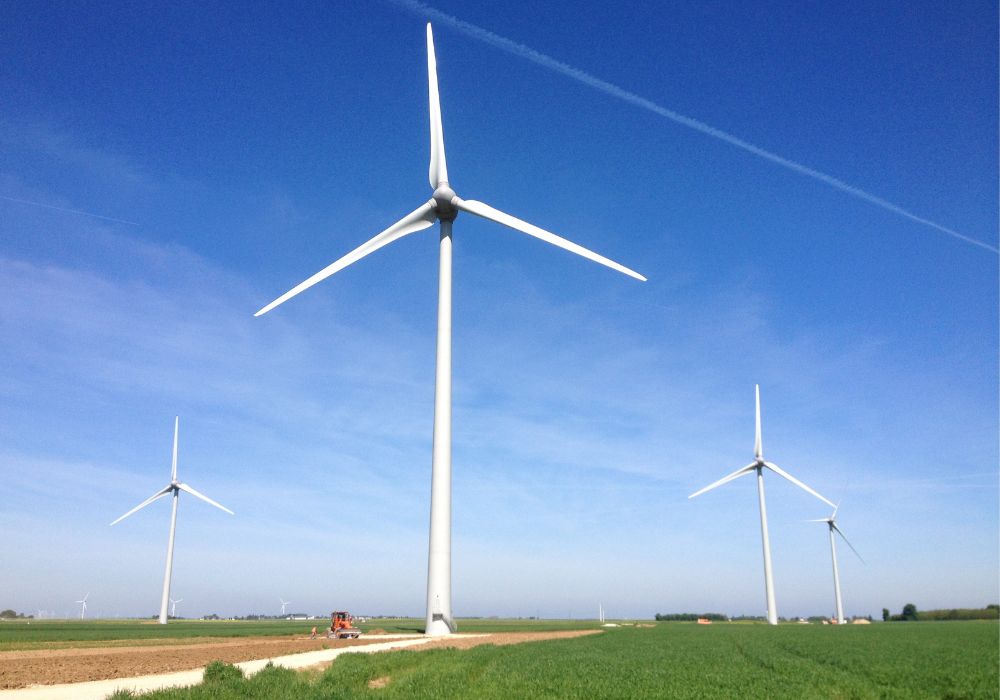For years, Quebec Premier François Legault has said that his province’s hydropower could make it the “battery of North America.” The province, long known for its giant hydro dams and electricity surpluses, has signed deals to sell its cheap and clean electricity to New York City and parts of New England. But as the electrification of everything from cars to home heating gets underway, surpluses are becoming a thing of the past, and some are questioning whether hydro dams alone can meet the province’s domestic demands for electricity in the future.
Now the Quebec government has announced that wind energy will become a larger piece of the province’s energy puzzle – as it will for the rest of the planet. One Longueuil-based company, betting big on wind and solar, is well positioned to fill the rising demand, at home and abroad. And that company has risen to the top of Corporate Knights’ 2023 ranking of Canada’s Best 50 Corporate Citizens.
Three decades of renewable energy
For more than 30 years, Innergex Renewable Energy has developed, owned and operated clean electricity facilities in Quebec. The company was founded in 1990 after the provincial government called for private sector bids to develop small hydro-generation facilities. A decade later, Innergex began scouting out locations for wind turbines in the Gaspé region, partnering with TransCanada Corporation (now TC Energy) on its first wind energy bid.
Having acquired B.C.’s Alterra Power Corporation in 2018 and Chile’s Energía Llaima in 2023, Innergex is now the largest independent renewable-energy company in both Canada and Chile, with expansion plans in the U.S. and France. Today, the $870.5-million company has a gross installed capacity of 4,244 megawatts (MW) of wind, solar and hydro – that’s more installed renewable capacity than the entire province of Ontario. And it plans to double that by 2025.
The ambitious energy transition plans of both the U.S. and Canada will require a lot of new clean energy. The U.S. government has committed to reducing greenhouse gas emissions by 50 to 52% by 2030 from 2005 levels, and Canada is aiming for a 40 to 45% reduction. Innergex CEO Michel Letellier plans to take advantage of these greening trade winds.
“There are few gains to be expected from hydroelectricity,” says Letellier at his Longueuil office on the South Shore of Montreal. Although a third of its facilities rely on hydroelectricity, Innergex plans for a diversified future. “The best sites for dams are occupied. And we won’t get more than 1.5%, maybe 2%, additional output from [existing hydro facilities]. In Quebec, wind power is the most promising.”
Decarbonization, energy security and independence will translate into growth for renewable-energy producers, confirms Anne Perreault, senior portfolio manager at Desjardins Global Asset Management. “Investors like that Innergex is diversified [solar, wind, hydro and batteries] and operates in several countries. But they have questions about financing growth. Currently, 84% of the credit line is used. So partnerships will need to be formed.”
A solid partner: Hydro-Québec
Since February 2020, Innergex has had a solid partner: Hydro-Québec. The Crown corporation (which topped the Best 50 ranking three of the last four years) paid $661 million in exchange for a 19.9% stake and committed to investing $500 million in joint projects. “The absence of reference shareholders made us too vulnerable to predators. We needed a shareholder who, without necessarily holding a majority stake in the capital of a company, has a stake large enough to influence its decisions,” says Letellier. “Every public company wants to maximize shareholder value. However, in our industry, value is not measured per quarter. We look at the long term. Hydro-Québec protects us from stormy weather.”
So far, this strategic alliance has resulted in one joint venture: acquiring the 60 MW Curtis Palmer portfolio of run-of-river hydroelectric plants in New York State. “We definitely want to establish other partnerships with Hydro-Québec, both in the U.S. and Quebec,” Letellier says.
On both sides of the U.S.-Canada border the future looks bright: governments are adopting policies and tax credits to encourage the rapid deployment of renewable-energy projects. Through the U.S. Inflation Reduction Act and budget measures announced in Canada, governments have trumpeted new incentives for renewables. But tax credits are only part of the equation to transition to renewable energy; transmission lines are critical to move the electricity generated to where it’s in demand.
“Our biggest challenge, in Canada and the U.S., is the interconnectedness of projects. All the developers aim for the same locations, creating bottlenecks. We desperately need more pipes,” says Letellier, referring to the need for more transition lines. The U.S. Midwest, for example, could be a Klondike for solar and wind power, but the majority of potential customers are in urban areas on the coasts.
No renewable-energy company will reach its targets without greater distribution capacity, Letellier explains. “Who will build those new transmission lines? Public utility companies? Private sector? This complex ownership structure and construction costs explain the lack of lines.”
Agreements with 31 Indigenous communities
Also critical to renewable-energy projects are community relationships. Innergex prides itself on its close ties with the communities that live near its projects. Things have changed since the big hydro projects of the 1970s, says Fred Vicaire, CEO of Mi’gmawei Mawiomi Business Corporation, Innergex’s Indigenous partner in Mesgi’g Ugju’s’n wind farm, in Gaspésie. “For many decades, we were just a box to check for companies to say, ‘We can do the project, we consulted with First Nations, and we will give them some royalties.’ We don’t want royalties from companies installing infrastructure in our territory. We want to own the projects 50/50 and get operating revenue from them.”
The Mesgi’g Ugju’s’n (MU) wind farm, located on public land in the regional county municipality of Avignon in Quebec’s Gaspé Peninsula, is indeed a 50/50 partnership between the three Mi’gmaq communities (Gesgapegiag, Gespeg and Listuguj) and Innergex. The first phase of MU is a 150 MW project. The second phase will add 102 MW.
Innergex has signed agreements with 31 Indigenous communities. “They go beyond financial terms,” says Vicaire. “These agreements take into account our way of life, including respect for hunting territories and lands used for traditional medicinal plants, for example.”
There are agreements, and there are agreements, cautions the Innergex CEO. “Unfortunately, over the years, too many renewable-energy companies have lacked transparency, negotiating with two different financial models: one designed for First Nations, showing no profitability, and one for the board and shareholders, which was profitable. An unequal relationship dating back to the fur trade era.”
“Since the early days, Innergex has believed in the three Ps: people, planet, profit,” he adds. “Every company aims for a return, but we’ve always believed it should be reasonable and never at the expense of the other two Ps.”
Partnerships can be challenging, especially when the partners don’t have access to the same equity. For the first phase of the MU wind farm, Innergex brought in more equity, says Vicaire. But the second phase “is different,” he says. “We have access to the First Nations Finance Authority. It finances projects at rates below prime, as municipalities would for large infrastructure projects.”
The green and the greening
Innergex’s relationships with Indigenous communities contribute to a strong “S” in the company’s ESG ratings. They also helped secure its spot at the top of the Best 50 ranking. As a pure-play renewable-energy business, the company scored top marks on sustainable revenue and sustainable investment, which were both at 100%. It also scored in the top quartile on energy productivity and carbon productivity.
Like Premier Legault, Letellier sees batteries in his future. He says that the next frontier for renewables is energy storage – keeping electricity flowing when the wind doesn’t blow and the sun doesn’t shine. Becoming an expert in deploying energy-storage technologies is part of Innergex’s strategic plan for 2020 to 2025. One battery project is already operational near the Yonne wind farm in France. Two others are under development in the Atacama Desert in northern Chile.
“We need all the help we can get to manage consumption,” Letellier says. “And it is clear that one day not so far away, every house will have its battery.”
Diane Bérard is an independent-solutions journalist based in Quebec.




